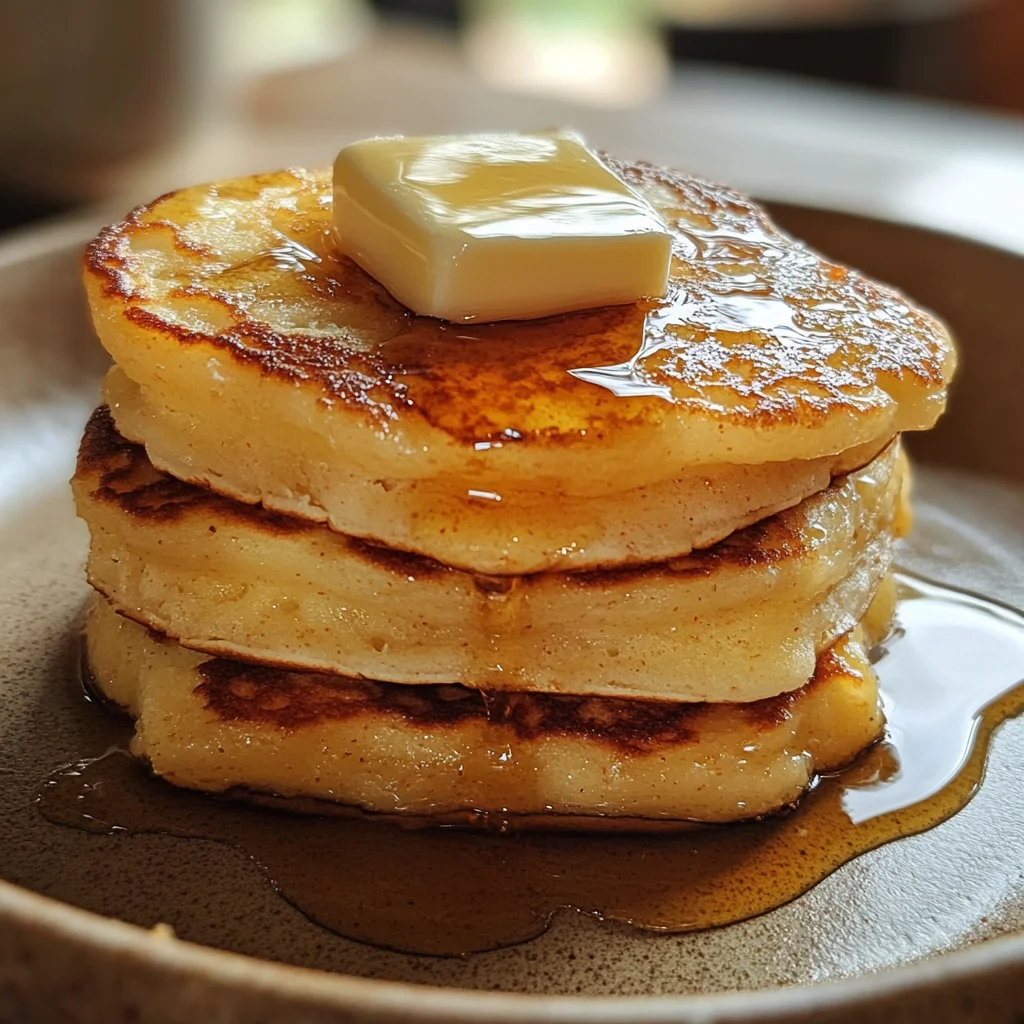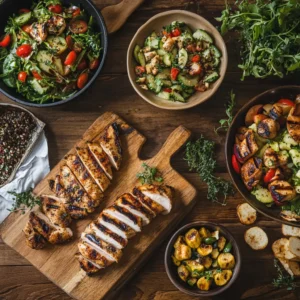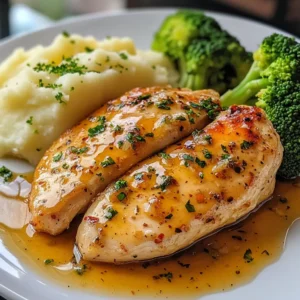If there’s one breakfast recipe that never fails to bring a smile to the table, it’s pancakes. But not just any pancakes — we’re talking about the timeless Joy of Cooking pancake recipe. This tried-and-true favorite is the kind of recipe that reminds you of Saturday mornings in grandma’s kitchen, batter on your sleeves and the sweet smell of breakfast dancing through the house.
In this ultimate guide, we’ll walk you through everything from the origins of the Joy of Cooking pancake recipe to expert tips on getting that golden-brown flip just right. Whether you’re cooking pancakes from scratch or looking for topping inspiration, you’ll find everything you need here to master the art of the pancakes joy of cooking recipe.
👉 Don’t miss our Easy Recipes for Thrifty Cooking for more everyday favorites.
A Legacy of Pancakes – The Joy of Cooking Connection
The Story Behind the Joy of Cooking Pancake Recipe
The Joy of Cooking isn’t just a cookbook — it’s practically a rite of passage. First published in 1931, it’s been a constant in American kitchens for nearly a century. And one of its most beloved staples? Pancakes. This humble recipe, nestled among classics like pot roast and chicken soup, has become a weekend favorite for good reason.
The pancakes joy of cooking recipe delivers a perfect balance of tender inside and golden outside, made with simple pantry ingredients that feel like a warm hug in food form. Its popularity lies in its simplicity. No need for fancy equipment or hard-to-find ingredients — just a bowl, a whisk, and a little patience.
The recipe has evolved slightly over the decades, but the essence remains the same: comfort food made accessible, dependable, and delicious.
Why This Pancake Recipe Stood the Test of Time
So, what makes this pancake recipe so timeless?
- It’s reliable. It works, every time. No guessing, no fluff (except for the pancakes themselves).
- It’s adaptable. Add buttermilk, toss in some blueberries, or sprinkle a touch of cinnamon — the recipe holds its own.
- It’s nostalgic. For many, this is the first recipe they learned to make on their own, often passed down through generations.
And let’s be honest — there’s something deeply satisfying about flipping pancakes on a quiet morning, watching the bubbles pop just before the perfect turn. That kind of joy? It sticks with you.
👉 Looking for inspiration? Try our Chicken and Rice in Rice Cooker Recipe for another comforting classic.
Gathering Your Ingredients for Pancake Joy
Before you even preheat your griddle or whip out the whisk, the first step to nailing the Joy of Cooking pancake recipe is getting your ingredients just right. What makes this pancake recipe so foolproof is how it combines pantry basics with the option to elevate things — depending on how indulgent or simple you’re feeling.
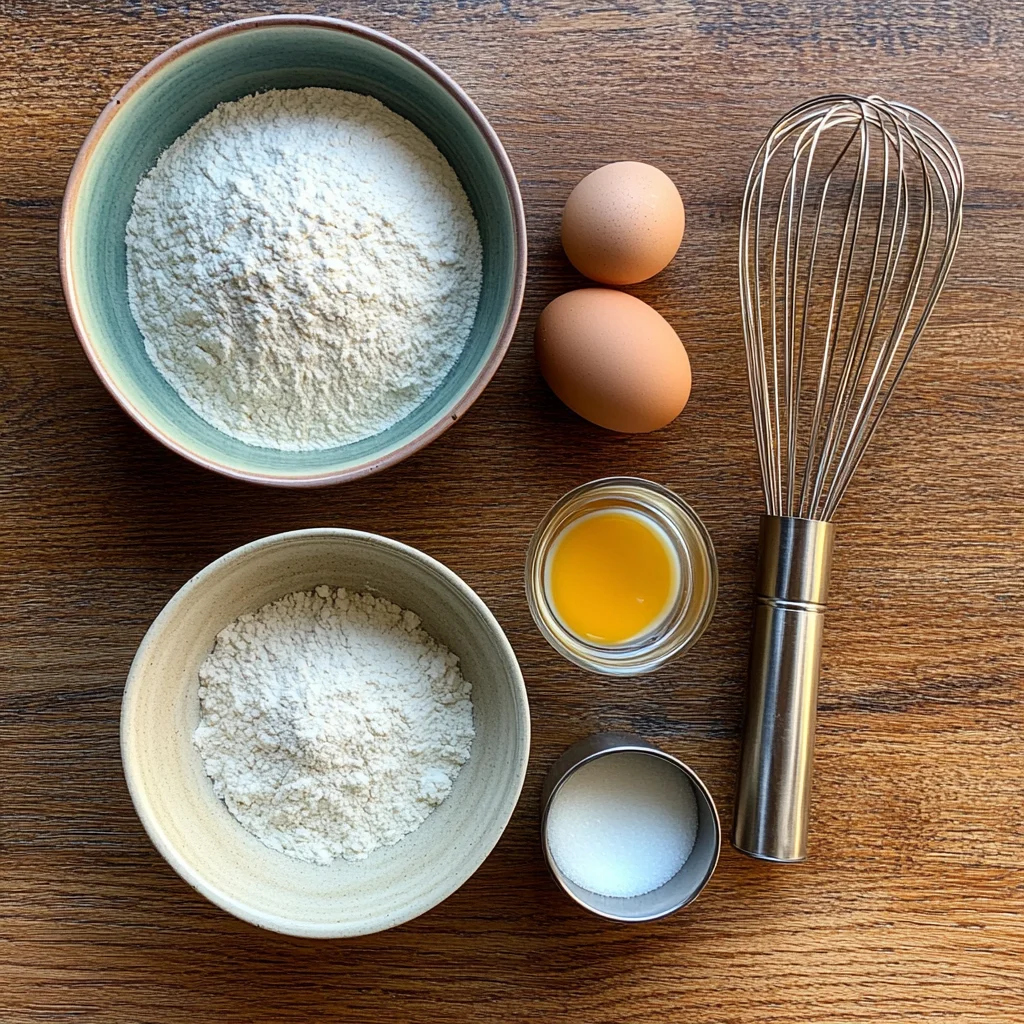
Must-Have Dry Ingredients for Perfect Pancakes
The foundation of any great pancake lies in the dry mix. In the Joy of Cooking version, the dry ingredients are straightforward but crucial to achieving the right texture and rise.
| Ingredient | Function | Notes |
|---|---|---|
| All-purpose flour | Base structure | Don’t overpack your measuring cup |
| Baking powder | Leavening for fluffiness | Use fresh — it’s the key to rise |
| Salt | Enhances flavor | Just a pinch makes a difference |
| Sugar | Balances flavor | Adjust based on toppings |
Pro Tip: Always sift or whisk your dry ingredients in a separate bowl before combining them with wet ones. This ensures even distribution and fewer clumps — nobody wants a bite full of baking powder.
➡️ Discover great ideas like Comfort Food with a Twist to add flavor to your mornings.
Essential Wet Ingredients and Pantry-Friendly Substitutes
The wet ingredients bind everything together, creating that smooth, pourable batter that makes pancakes a dream to work with.
- Milk or Buttermilk: Milk works great, but buttermilk gives your pancakes that extra tang and tenderness. No buttermilk? Add 1 tablespoon of lemon juice or vinegar to a cup of whole milk and let it sit for 5–10 minutes.
- Egg: It binds and lifts. One large egg is all you need.
- Melted Unsalted Butter or Oil: For richness and moisture. Butter adds flavor, oil makes things easy.
- Vanilla Extract (optional): A small splash adds warmth and complexity.
| Liquid Ingredient | Quantity | Substitute |
|---|---|---|
| Whole milk | 1 cup | Almond, oat, or buttermilk |
| Egg | 1 large | Flax egg (for vegan option) |
| Melted butter | 2 tbsp | Neutral oil like canola or avocado oil |
You’ll mix these wet ingredients in a separate bowl — and when they hit the dry mix, magic begins.
Pro Tip: Make a well in the center of your dry ingredients before pouring in the wet. This trick helps everything blend together evenly, without overmixing.
👉 Don’t miss our 15 Bean Soup Slow Cooker Recipe — another cozy kitchen essential for your recipe box.
Mixing Pancake Batter the Right Way
If you’ve ever wondered why your pancakes came out flat or rubbery, chances are the culprit was in the mixing. The Joy of Cooking pancake recipe emphasizes simplicity, but even simple recipes need the right technique.
How to Combine Wet and Dry Ingredients
You’ve got two bowls: one with your whisked dry ingredients and one with your smooth, wet ingredients. Now it’s time to bring them together, and this is where you need to slow down just a bit.
Step-by-step:
- Make a well in the center of your dry mix.
- Slowly pour the wet mixture into the well.
- Using a fork or whisk, gently fold the dry ingredients into the wet. Start from the center and pull the dry mix into the wet in circular motions.
- Stop mixing when you see most of the flour absorbed. A few small lumps are totally fine — they’ll smooth out as the batter rests and cooks.
| Tip | Why It Matters |
|---|---|
| Use a large mixing bowl | Gives you space to stir without overworking |
| Avoid electric mixers | Too much power = tough pancakes |
| Let the batter rest | 5–10 minutes lets the gluten relax and air bubbles form |
This method gives the batter the structure it needs without making it dense or chewy.
Tips to Avoid Overmixing and Lumpy Batter
Overmixing is pancake public enemy #1. Why? Because it activates the gluten in the flour, which leads to dense, rubbery results — and that’s a far cry from fluffy perfection.
Avoid these mistakes:
- Don’t aim for smooth. Pancake batter should look slightly bumpy. Smooth = overmixed.
- Never beat the batter. Stir gently, using a folding motion instead.
- Don’t keep adding liquid. It might look thick, but trust the batter. It should slowly pour, not run.
Let the batter sit while you preheat your griddle or skillet. This resting time gives the baking powder a chance to do its thing and creates air bubbles — the secret to that light, airy bite.
👉 Check out Easy Weeknight Meals for other foolproof recipes that come together just as easily.
Mastering the Cooking Pancakes Process
Now that your batter is resting and ready, it’s time to get cooking. Pancakes may seem simple, but there’s a bit of an art to getting the golden crust, the fluffy center, and that just-right flip. The Joy of Cooking pancake recipe keeps it straightforward, but technique makes all the difference.
How to Test Your Griddle or Pan for the Right Temperature
The #1 reason pancakes burn or don’t rise? Starting with the wrong heat.
Here’s how to get the pan just right:
- Use a non-stick skillet or cast iron griddle — both work, just make sure it’s clean and dry.
- Preheat the pan on medium heat for 5 minutes.
- Test with a few water droplets — if they sizzle and skip across the surface, it’s hot enough. If they evaporate instantly, it’s too hot. If they sit there quietly, not hot enough.
Add a small pat of butter or a swirl of neutral oil. Wipe off excess with a paper towel so the pancakes don’t fry, just brown gently.
| Temperature Test | Result |
|---|---|
| Drops dance | Ready |
| Drops vanish fast | Too hot |
| Drops sit still | Too cold |
Step-by-Step Cooking Instructions from Pour to Flip
- Scoop and pour: Use a ¼-cup measuring cup to pour your batter onto the hot surface. Leave space between pancakes so they don’t merge.
- Watch for bubbles: As the batter cooks, bubbles will form on top — this is your cue.
- Edges should look set: They’ll go from shiny to slightly matte. That’s your flip signal.
- Flip gently but confidently. Use a flat spatula, and turn it in one smooth motion.
- Cook the other side: It’ll take about 1–2 minutes to finish. Pancakes should be golden brown and spring back when gently touched.
Pro Tips for Best Results:
- Don’t press them down. You’ll squeeze out all that fluffy goodness.
- Wipe and re-grease the pan every batch or two to prevent burnt butter buildup.
- Keep cooked pancakes warm in a low oven (200°F) on a wire rack.
| Cooking Time | Each Side |
|---|---|
| Side One | 2–3 minutes |
| Side Two | 1–2 minutes |
And remember, the first pancake is often a tester — use it to adjust heat or batter thickness if needed.
Tips and Tricks for Fluffy Pancakes Every Time
A pancake can taste great and still fall flat — literally. The signature of the Joy of Cooking pancake recipe is its fluff, that light and airy lift that turns breakfast into something blissful. Here’s how to get that lift every single time, whether you’re a beginner or a seasoned weekend chef.
The Role of Baking Powder and Buttermilk
These two ingredients are the MVPs when it comes to fluffy structure.
- Baking Powder: This is your leavening agent. It releases carbon dioxide as it heats up, creating air pockets that puff up the pancake. Make sure it’s fresh — it loses potency over time.
- Buttermilk: The slight acidity in buttermilk reacts with baking powder and baking soda, producing even more lift. It also breaks down some of the gluten, which leads to a tender bite.
No buttermilk? DIY it by adding 1 tbsp vinegar or lemon juice to 1 cup whole milk. Let it sit for 5–10 minutes.
| Ingredient | Function | Best Substitute |
|---|---|---|
| Baking powder | Adds rise and fluff | Mix of baking soda + cream of tartar |
| Buttermilk | Tenderizes and reacts with leavening | Whole milk + vinegar |
Pro Tip: If you’re using buttermilk, you can also include ¼ tsp of baking soda to boost that reaction. The Joy of Cooking sometimes recommends this tweak for extra height.
Temperature, Timing, and the Secret to Fluffiness
Even with the right ingredients, your cooking process can make or break fluff potential.
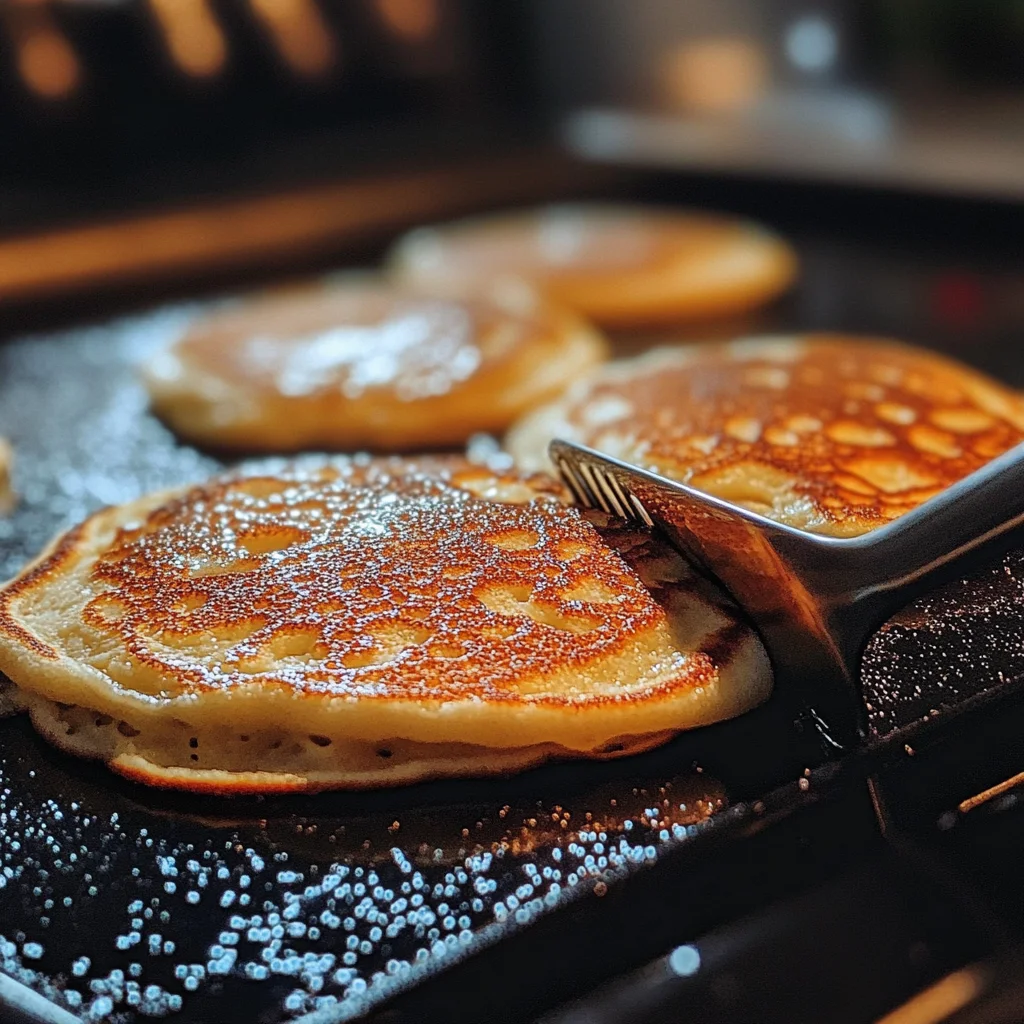
Here’s the secret sauce:
- Rest your batter. Let it sit 5–10 minutes after mixing. This allows air bubbles to form and flour to fully hydrate.
- Don’t overmix. As mentioned earlier, lumps are OK. Smooth batter = overworked gluten = flat cakes.
- Use medium heat. Too hot and the outside cooks before the inside can rise. Too low and they spread thin.
- Flip only once. Constant flipping deflates your pancake and causes uneven cooking.
| Action | Fluff Factor |
|---|---|
| Let batter rest | High boost |
| Stir gently | Essential |
| Flip once only | Maintains structure |
| Right heat | Prevents collapse |
Bonus Tip: Want perfectly fluffy pancakes every time? Separate your egg — whip the white into soft peaks and fold it into your batter last. It’s an extra step, but it’ll make those pancakes practically levitate.
Creative Pancake Variations & Toppings to Try
The beauty of pancakes is that they’re basically a blank slate for flavor. Once you’ve mastered the base recipe, it’s time to get creative — with mix-ins, toppings, and even savory spins. The Joy of Cooking approach encourages customization, and here’s how to make it your own.

Flavor Twists: Vanilla, Cinnamon, and Fruit Mix-Ins
Want to add a touch of personality to your batter? Just a few ingredients can totally change the flavor profile without complicating the process.
Sweet Add-Ins:
- Vanilla extract: A teaspoon adds cozy warmth.
- Cinnamon or nutmeg: Just ¼ tsp adds depth and pairs perfectly with maple syrup.
- Chocolate chips: Sprinkle directly on the batter after pouring it onto the pan.
- Berries (blueberries, raspberries): Add fresh or frozen berries to the batter for juicy bites.
| Add-In | Amount | Add to |
|---|---|---|
| Vanilla extract | 1 tsp | Wet mix |
| Cinnamon | ¼ tsp | Dry mix |
| Blueberries | ½ cup | Batter or on top |
| Chocolate chips | ¼ cup | Batter (after pouring) |
Pro Tip: To avoid purple batter, dust berries in flour before folding them in — it helps them stay suspended instead of sinking.
Savory Swaps:
- Cheddar + chives: Great for brunch, topped with a fried egg.
- Cooked bacon bits: Fold into the batter or sprinkle on top.
- Corn + jalapeños: For a Southwest-style pancake that pairs well with hot sauce.
Toppings Galore: Syrups, Spreads, and Savory Ideas
Once your pancakes are off the griddle, it’s topping time. Whether you like them syrup-soaked or piled with whipped cream and fruit, here are combinations that elevate breakfast (or dinner — we don’t judge).
Classic Toppings:
- Maple syrup (warm it first — trust us)
- Butter or compound butter (try honey cinnamon butter!)
- Powdered sugar for a simple finish
Next-Level Ideas:
- Yogurt + honey + granola
- Nut butter + banana slices
- Lemon curd + fresh berries
- Mascarpone + fig jam for something fancy
Savory Pancake Toppings:
- Fried egg + avocado + hot sauce
- Smoked salmon + cream cheese + herbs
- Pulled pork + slaw (yes, seriously)
| Topping Type | Ideas |
|---|---|
| Sweet | Syrup, whipped cream, fruit, chocolate drizzle |
| Savory | Cheese, herbs, eggs, smoked meats |
| Fresh | Yogurt, fresh berries, sliced stone fruit |
You can even create a pancake bar for brunch gatherings with various toppings and let everyone build their own stack. It’s casual, fun, and perfect for both kids and grown-ups.
👉 Learn more about Comfort Food with a Twist to find more ways to turn simple meals into memorable ones.
Storing, Reheating, and Freezing Pancakes Like a Pro
One of the best things about homemade pancakes? They make the perfect leftovers. And when stored right, they taste just as good the next day — or next week. Whether you’re meal-prepping or just made too many (been there), here’s how to keep your pancakes fluffy, moist, and ready to go.
Best Ways to Store Leftover Pancakes
Got extras? Awesome. Here’s how to handle them:
🌡️ Room Temperature (Short-Term)
If you plan to eat them within a few hours:
- Let them cool completely on a wire rack (not a plate — it traps steam).
- Stack with parchment or wax paper between them to prevent sticking.
- Cover with foil or plastic wrap and leave at room temp up to 4 hours.
🧊 Refrigerator (2–3 Days)
For a couple of days’ storage:
- Stack pancakes with parchment between layers.
- Place in an airtight container or zip-top bag.
- Label with the date. Good for up to 3 days.
❄️ Freezer (Up to 2 Months)
Batch-cooking? Pancakes freeze beautifully.
- Cool completely, then lay pancakes flat on a baking sheet.
- Freeze for 1–2 hours, then transfer to a freezer-safe bag.
- Press out excess air and label the bag with the date.
- Use within 2 months for best flavor and texture.
| Storage Method | Duration | Notes |
|---|---|---|
| Room Temp | Up to 4 hours | Cool completely first |
| Refrigerator | 2–3 days | Store airtight |
| Freezer | Up to 2 months | Flash freeze first |
How to Reheat Pancakes Without Losing Fluff
Skip the microwave when possible — it makes pancakes rubbery. Use one of these three methods instead:
🔥 Oven (Best for Multiple Pancakes)
- Preheat to 350°F.
- Place pancakes on a baking sheet in a single layer.
- Cover loosely with foil to prevent drying.
- Heat for 6–8 minutes, or until warm.
🍳 Skillet (Quick + Crisp Edges)
- Heat a nonstick skillet over medium-low.
- Add a tiny bit of butter or oil.
- Reheat pancakes for 30–45 seconds per side.
📦 Microwave (Fastest Option)
- Stack 2–3 pancakes on a plate.
- Cover with a damp paper towel.
- Microwave for 20–30 seconds.
Pro Tip: If reheating from frozen, no need to thaw — just extend cook time slightly depending on your method.
👉 Looking for inspiration? Try Chicken and Rice in Rice Cooker Recipes for another easy, meal-prep-friendly option.
Frequently Asked Questions about Pancakes Joy of Cooking Recipe
Got questions? You’re not alone. Whether you’re whipping up pancakes for a lazy Sunday breakfast or making a big batch for dinner (yep, breakfast-for-dinner is a thing here), these answers will help you troubleshoot and level up your pancake game.
What is the trick to good pancakes?
The real trick? Don’t overthink it.
- Use fresh leavening: Make sure your baking powder isn’t expired.
- Let the batter rest: Give it 5–10 minutes after mixing.
- Don’t overmix: Stir just until combined — some lumps are totally fine.
- Cook on medium heat: Too hot and they burn, too cool and they spread flat.
- Flip once, gently: That’s all you need for a golden-brown finish.
The Joy of Cooking pancake recipe nails all of these essentials, which is why it’s a go-to.
Why are my homemade pancakes not fluffy?
Flat pancakes usually mean one (or more) of these issues:
- Old baking powder
- Overmixed batter
- Skipping the rest time
- Cooking them on too cold or too hot of a surface
Check your ingredient freshness and keep that wrist gentle — fluffiness is more about technique than fancy ingredients.
How to bake pancakes step by step?
Here’s a simple breakdown of the Joy of Cooking pancake method:
- Mix dry ingredients in one bowl: flour, baking powder, salt, sugar.
- Whisk wet ingredients in another: milk, egg, melted butter or oil, and vanilla if using.
- Combine gently, just until mixed — a few lumps are fine.
- Rest the batter for 5–10 minutes.
- Preheat your pan and test for readiness with water droplets.
- Scoop and cook: Pour ¼ cup of batter onto hot, lightly greased griddle.
- Flip when bubbles form and edges look set.
- Finish and serve with your favorite toppings.
How to use pancake mix?
Shortcut days are real — and pancake mix can still deliver joy if done right.
- Follow the box instructions, but feel free to add a dash of vanilla, swap in buttermilk, or stir in fruit for extra flavor.
- Don’t skip the resting period — yes, even for mix!
- Want fluffier results? Try whisking an egg white and folding it into the mix.
Remember: even a mix benefits from Joy of Cooking techniques.
What is the secret to fluffy pancakes?
We’ve said it before, but it bears repeating:
- Fresh baking powder
- Gentle mixing
- Batter rest time
- Medium heat
- One flip only
Bonus move: separate your eggs and whip the whites for max fluff. Fold into the batter just before cooking. Magic.
Do pancakes taste better with water or milk?
Always go for milk — or better yet, buttermilk.
- Water gives you texture but zero richness.
- Milk adds flavor, browning, and body.
- Buttermilk? That tangy depth and perfect crumb can’t be beat.
If you’re dairy-free, use oat or almond milk for a decent substitute. But milk is the gold standard.
👉 Check out Easy Recipes for Thrifty Cooking for more great meals using pantry staples and clever swaps.
Conclusion – Rediscover the Joy of Pancakes
There’s something quietly magical about pancakes. Maybe it’s the sizzle when the batter hits the griddle, or the way they puff up like little clouds of comfort. Or maybe it’s what they represent — slow mornings, shared smiles, sticky fingers, and full hearts.
The pancakes joy of cooking recipe isn’t just a breakfast staple — it’s a tradition, a memory-maker, and a delicious reminder that the best meals come from the simplest ingredients and a little love. Whether you’re serving up a stack to your kids before school or flipping flapjacks for a Sunday brunch with friends, these pancakes are your go-to.
Let’s recap the essentials for the best results:
- Stick to fresh ingredients, especially baking powder.
- Don’t skip the rest time — it makes a big difference.
- Use medium heat and flip only once.
- Customize freely with toppings and add-ins.
- Store smartly so you can enjoy them any day of the week.
Breakfast doesn’t need to be complicated to be special — and with the Joy of Cooking pancake recipe, you’ve got all the tools to turn everyday mornings into something a little extra joyful.
👉 Don’t miss our 15 Bean Soup Slow Cooker Recipe for another comforting classic that brings warmth to your table.
Want more visual inspiration?
👉 Follow us on Pinterest at Golden Bite Recipes for mouthwatering stacks, recipe boards, and breakfast ideas you’ll love.
